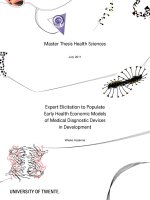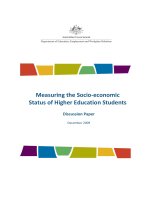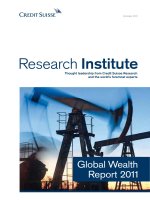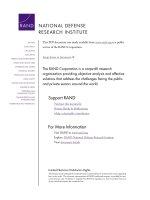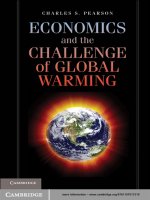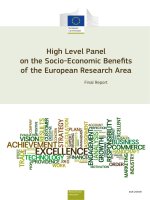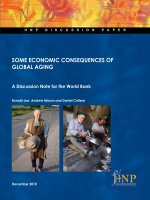Warming the World Economic Models of Global Warming
Bạn đang xem bản rút gọn của tài liệu. Xem và tải ngay bản đầy đủ của tài liệu tại đây (1.42 MB, 245 trang )
William D. Nordhaus
•
Joseph Boyer
“Warming the World should be required reading for
policy makers, politicians, environmentalists, and
the concerned public.”
—Thomas Gale Moore, Journal of Political Economy
Warming the World
Economic Models of Global Warming
Warming the World
Warming the World
Economic Models of
Global Warming
William D. Nordhaus and
Joseph Boyer
The MIT Press
Cambridge, Massachusetts
London, England
© 2000 Massachusetts Institute of Technology
All rights reserved. No part of this book may be reproduced in any form by any electronic or mechanical means (including photocopying, recording, or information storage
and retrieval) without permission in writing from the publisher.
This book was set in Palatino by Best-set Typesetter Ltd., Hong Kong
Printed and bound in the United States of America.
Library of Congress Cataloging-in-Publication Data
Nordhaus, William D.
Warming the world : economic models of global warming / William D. Nordhaus and
Joseph Boyer.
p. cm.
Includes bibliographical references and index.
ISBN 0-262-14071-3 (hc. : alk. paper)
1. Global warming—Economic aspects—Mathematical models. 2. Economic
development—Environmental aspects—Mathematical models. I. Boyer, Joseph, 1969–
II. Title.
QC981.8.G56.N67
363.738¢74—dc21
2000
00-029230
Contents
List of Tables vii
List of Figures ix
Preface xi
I Developing the RICE and DICE Models
1 Introduction
1
3
2 The Structure and Derivation of RICE-99
9
Overview of Approach 9
Model Description 10
Derivation of the Equations of RICE-99 14
Equilibrium in the Market for Carbon-Energy
Policy in RICE-99 24
24
3 Calibration of the Major Sectors 27
Regional Specification 27
Calibration of Production Function
41
Exogenous Trend Parameters 46
Carbon Supply 53
The Carbon Cycle and Other Radiative Forcings
The Climate Module 62
4 The Impacts of Climate Change 69
Early Impact Studies 69
The Present Approach 71
Discussion of Individual Sectors 74
Impact Indices as Functions of Temperature
Calibration of the RICE-99 Damage Function
Major Results and Conclusions 95
89
94
56
vi
Contents
5 The DICE-99 Model 99
Model Structure 99
Calibration 101
6 Computational Procedures 107
Computer Programs for RICE and DICE 107
Solution Approach in EXCEL—RICE-99 107
Solution Approach in GAMS—RICE-99 109
DICE
114
GAMS versus EXCEL 114
II Policy Applications of the RICE Model
119
7 Efficient Climate-Change Policies 121
Alternative Approaches to Climate-Change Policy
Detailed Description of Different Policies 123
Major Results 127
8 Economic Analysis of the Kyoto Protocol 145
Climate-Change Policy and the Kyoto Protocol
Economic Analysis of the Kyoto Protocol 147
Major Results 149
Findings and Conclusions 166
121
145
9 Managing the Global Commons 169
Background
169
Summary of the Model and Analysis 170
Major Results 174
Analysis of the Kyoto Protocol 176
Concluding Thoughts 178
Appendix A: Equations of RICE-99 Model 179
Appendix B: Equations of DICE-99 Model 181
Appendix C: Variable List 183
Appendix D: GAMS Code for RICE-99, Base Case and Optimal
Case
189
Appendix E: GAMS Code for DICE-99 207
References 217
Index 227
Tables
Table 1.1
Reference case output across model generations
5
Table 1.2
Difference in radiative forcing across models,
reference case, 2100 7
Table 3.1
Regional details of the RICE-99 model
Table 3.2
Major regional aggregates in RICE-99 regions
Table 3.3
Growth rates of per capita GDP: Regional averages
Table 3.4
Growth rates of commercial energy/GDP ratio:
Regional averages 40
Table 3.5
Growth rates of CO2-GDP ratio: Regional averages
Table 3.6
Comparison of RICE-99 with Maddison projections
Table 3.7
Growth in per capita output in RICE-99 regions:
Historical rates and projections 49
Table 3.8
Comparison of RICE-99 reference case with IIASA
scenario B 52
Table 3.9
Non-CO2 radiative forcings according to IPCC-90,
MAGICC/IPCC-99, and RICE-99 63
Table 4.1
Estimated impact from IPCC report, 1996
Table 4.2
Regions in impact analysis
Table 4.3
Subregional mean temperature
Table 4.4
Estimated damages on agriculture from CO2
doubling 76
Table 4.5
Coastal vulnerability
Table 4.6
Vulnerability of economy to climate change
Table 4.7
Years of life lost from climate-related diseases
Table 4.8
Impact of global warming on climate-related
diseases 83
28
39
70
72
73
78
79
81
40
41
48
viii
Table 4.9
Tables
Willingness to pay to eliminate risk of catastrophic
impact 90
Table 4.10 Summary of impacts in different sectors
91
Table 4.11 Comparison of recent impact studies, United States
Table 5.1
Comparison of RICE-99 and DICE-99 results,
reference case 103
Table 5.2
Comparison of RICE-99 and DICE-99 results,
optimal case 105
Table 6.1
The Basic policies of the RICE model
Table 6.2
Comparison between GAMS and EXCEL solutions
Table 7.1
Alternative policies analyzed in RICE-99 and
DICE-99 models 122
Table 7.2
Global net economic impact of policies
Table 7.3
Abatement cost and environmental benefits of
different policies 130
Table 7.4
Regional net economic impact of policies
Table 7.5
Carbon taxes in alternative policies
Table 7.6
Emissions control rates in alternative policies
Table 7.7
Industrial CO2 emissions in alternative policies
Table 7.8
Temperature in alternative policies
Table 8.1
Runs for the analysis of Kyoto Protocol
Table 8.2
Industrial carbon emissions for alternative
approaches to Kyoto Protocol 151
Table 8.3
Comparison of global mean temperature increase in
different approaches to Kyoto Protocol 153
Table 8.4
Comparison of carbon taxes, 2015 and 2105, in
different approaches to Kyoto Protocol 155
Table 8.5
Discounted abatement costs in different strategies
Table 8.6
Abatement costs in different regions for different
policies 159
Table 8.7
Net economic impacts in different regions for
different policies 160
Table 8.8
Benefits, costs, and benefit-cost ratios of different
approaches 164
97
110
113
128
131
133
137
137
141
147
157
Figures
Figure 3.1 Industrial CO2-output ratios for thirteen RICE
subregions, 1995 42
Figure 3.2 Growth in per capita output
50
Figure 3.3 Rates of growth in CO2 emissions/GDP ratio
Figure 3.4 Carbon supply function in RICE-99 model
51
55
Figure 3.5 Impulse response functions for different models
61
Figure 3.6 Comparison of projections of CO2 concentrations
from RICE-99 and Bern models for IS92a
emissions projection 62
Figure 3.7 Comparison of temperature simulation of
RICE-99 model with IPCC-96 66
Figure 4.1 Agricultural damage function
92
Figure 4.2 Health damages from model and Murray-Lopez
study 94
Figure 4.3 Global damage function
95
Figure 4.4 Regional damage functions
96
Figure 5.1 Calibration error in DICE reference case
Figure 5.2 Calibration error in DICE optimal case
Figure 7.1 Global net economic impact
102
104
128
Figure 7.2 Carbon taxes: Alternative policies
132
Figure 7.3 Carbon taxes: Alternative policies
134
Figure 7.4 Emission control rates: Alternative policies
Figure 7.5 Optimal emissions control rate by region
135
136
Figure 7.6 Industrial CO2 emissions: Alternative policies
138
x
Figures
Figure 7.7 Regional industrial CO2 emissions in base case
Figure 7.8 CO2 concentrations: Alternative policies
Figure 7.9 Global mean temperature
139
140
Figure 7.10 Per capita income in base run
143
Figure 7.11 Industrial carbon intensity: Base case
Figure 8.1 Global industrial CO2 emissions
150
Figure 8.2 Atmospheric CO2 concentration
152
Figure 8.3 Global temperature increase
144
153
Figure 8.4 Carbon taxes in different policies
154
Figure 8.5 Abatement costs in different strategies
Figure 8.6 Impact of policy on world GDP
158
Figure 8.7 Regional impacts of alternative strategies
Figure 8.8 Overall impacts of alternative strategies
Figure 8.9 Net economic impact by region
157
165
161
163
138
Preface
Dealing with complex scientific and economic issues has increasingly
involved developing scientific and economic models that help analysts
and decision makers understand likely future outcomes as well as the
implications of alternative policies. This book presents the details of
a pair of integrated-assessment models of the economics of climate
change. The models, called RICE-99 (for the Regional Dynamic Integrated model of Climate and the Economy) and DICE-99 (for the
Dynamic Integrated model of Climate and the Economy), build upon
earlier work by Nordhaus and collaborators, particularly the DICE
and RICE models constructed in the early 1990s. The purpose of this
book is to lay out the logic and details of RICE-99 and DICE-99. Like
an anatomy class, this description highlights internal structure of the
models and the ways different segments are connected.
The book is organized into two parts. The first part describes RICE99 and its globally aggregated companion, DICE-99. This part contains
an introduction (chapter 1) and a brief description of RICE-99 (chapter
2) that includes all the model equations. The details of the derivation
of these equations and their parameterization are presented in chapters 3 and 4. Chapters 1 through 4 present RICE-99, leaving explicit discussion of DICE-99 to chapter 5. Chapter 6 explains how the models
are solved. Part II presents the major results of RICE-99 and applies it
to the questions surrounding climate change. The appendixes provide
a summary listing of the equations, a variable list, and the programs
for the RICE-99 and DICE-99 models. The models and spreadsheets are
also available on the Web.
Those interested in this exciting field will recognize that this book
builds on earlier work of the authors and of many others. Although it
bears the names of two authors, the intellectual inspiration and contribution of many should be recognized. Among those we thank for
xii
Preface
contributing directly or indirectly are Jesse Ausubel, Howard Gruenspecht, Henry Jacoby, Dale Jorgenson, Charles Kolstad, Alan Manne,
Robert Mendelsohn, Nebojsa Nakicenovic, John Reilly, Richard Richels,
Thomas Schelling, Richard Schmalensee, Stephen Schneider, Leo
Schrattenholzer, Robert Stavins, Ferenc Toth, Karl Turekian, Paul
Waggoner, John Weyant, Zili Yang, and Gary Yohe. Megan McCarthy
and Ben Gillen provided valuable research assistance. This research
was supported by the National Science Foundation and the Department of Energy. None of these is responsible for the errors, opinions,
or flights of fancy in this work.
I
Developing the RICE and
DICE Models
1
Introduction
“God does not play dice with the universe,” was Albert Einstein’s reaction to quantum mechanics. Yet humanity is playing dice with the
natural environment through a multitude of interventions: emitting
into the atmosphere trace gases like carbon dioxide that promise
to change the global climate, adding ozone-depleting chemicals,
engineering massive land-use changes, and depleting multitudes of
species in their natural habitats, even as we create in the laboratory new
organisms with unknown properties. In an earlier era, human societies
learned to manage—or sometimes failed to learn and mismanaged—
the grazing or water resources of their local environments. Today, as
human activity increasingly affects global processes, we must learn to
use wisely and protect economically our common geophysical and biological resources. This task of understanding and controlling interventions on a global scale is managing the global commons.
Climatologists and other scientists warn that the accumulations of
carbon dioxide (CO2) and other greenhouse gases (GHGs) are likely to
lead to global warming and other significant climatic changes over the
next century. This prospect has been sufficiently alarming that governments have undertaken, under the Kyoto Protocol of December 1997,
to reduce their GHG emissions over the coming years. The Kyoto
Protocol raises a number of fundamental issues: Are the emissions
limitations proposed there sufficient, insufficient, or excessive? Is the
mechanism proposed to combat global warming—limiting emissions
from high-income countries—workable and desirable? Was it wise to
omit developing countries? Is there a trajectory for the Kyoto Protocol
that will lead to a comprehensive climate-change policy? Are other
approaches, such as harmonized carbon taxes or geoengineering,
worth considering? How does the approach in the Kyoto Protocol
compare with the economist’s dream of an “efficient” policy? And,
4
Chapter 1
perhaps most important, will these costly approaches sell in the
political marketplace of the world’s democracies and oligarchies?
Natural scientists have pondered many of the scientific questions
associated with greenhouse warming for a century. But the economic,
political, and institutional issues have only begun to be considered over
the last decade. The intellectual challenge here is daunting—raising
formidable issues of data, modeling, uncertainty, international coordination, and institutional design. In addition, the economic stakes are
enormous. Several recent studies of the Kyoto Protocol put the price
tag on abatement to be around $1 trillion in present value.1 It is no
hyperbole to say that the issue of greenhouse warming invokes the
highest form of global citizenship—where nations are being called
upon to sacrifice hundreds of billions of dollars of present consumption in an effort that will largely benefit people in other countries,
where the benefit will not come until well into the next century and
beyond, and where the threat is highly uncertain and based on
modeling rather than direct observation.
The issue of global warming has proven one of the most controversial and difficult problems facing nations as they cross the bridge into
the twenty-first century. Over the last decade, the issue has migrated
from the scientific journals to White House conferences and world
summit meetings. In response, a small navy of natural and social
scientists has been mobilized to help improve our understanding. In
parallel with the growing interest, industrial, environmental, and political groups have put their oars in the water to pull the ship in directions favorable to their ideologies or bottom lines.
Among the most impressive advances over the last decade has
been the development of integrated-assessment economic models that
analyze the problem of global warming from an economic point of
view. Literally dozens of modeling groups around the world have
brought to bear the tools of economics, mathematical modeling, decision theory, and related disciplines. Whereas a decade ago, not a single
integrated dynamic model of the economics of climate change existed,
there are now more than we can keep track of.
One of the earliest dynamic economic models of climate change was
the DICE model (a Dynamic Integrated model of Climate and the
Economy). Originally developed from a line of energy models, DICE
integrated in an end-to-end fashion the economics, carbon cycle,
1. See the studies contained in Weyant 1999.
Introduction
5
Table 1.1
Reference case output across model generations for the year 2100
Industrial emissions (GtC/year)1
Output (trillions of 1990 U.S.$)
Population (billions)
Output per person (thousands of 1990 U.S.$)
Carbon intensity (tons carbon per $1,000 of GDP, 1990 U.S.$)
Temperature (degrees C above 1900)
DICE-94
RICE-99
24.9
111.5
9.8
11.4
0.22
3.39
12.9
97.02
10.7
9.1
0.13
2.42
Note: 1. “GtC” means billion metric tons of carbon.
Source: Runs of models as described in text.
climate science, and impacts in a highly aggregated model that allowed
a weighing of the costs and benefits of taking steps to slow greenhouse
warming. The first version of DICE was presented in 1990, and the
results of the full model were described in Nordhaus 1994b. A regionalized version, known as RICE (a Regional dynamic Integrated model
of Climate and the Economy), was developed and presented in
Nordhaus and Yang 1996.
Although the basic structure of the DICE and RICE models has survived in the crucible of scientific criticism, further developments in
both economics and the natural sciences suggest that major revisions
of the earlier approaches would be useful. Although no simple solutions have been found, a number of small discoveries and large innovations in the natural and social sciences have come forth. Moreover,
the past decade has seen major improvements in the underlying data
on greenhouse-gas emissions and energy and economic data.
This book represents the fruits of the revision of the earlier models.
The new models have benefited from a thorough overhaul while maintaining their basic structure. Table 1.1 compares projections of the major
variables in RICE-99 with the earlier DICE-94 model for the reference
case in 2100.2
The major changes from the old to the new models are the following:
1. The major methodological change is a respecification of the production relations. Whereas the earlier DICE and RICE models used a
2. The reference case represents the model’s projections for what will happen if no government control over GHG emissions is imposed. See chapter 2, section four, or chapter
6 for more complete definition.
6
Chapter 1
parameterized emissions–cost relationship, the new RICE model use a
three-factor production function in capital, labor, and carbon-energy.
The new RICE model develops an innovative technique for representing the demand for carbon fuels and uses existing energy-demand
studies for calibration.
2. The new RICE model changes the treatment of energy supply to
incorporate the exhaustion of fossil fuels. This approach treats the
supply of fossil fuels explicitly and uses a market-determined process
to drive the depletion of exhaustible carbon fuels. The new model
incorporates a depletable supply of carbon fuels, with the marginal cost
of extraction rising steeply after 6 trillion tons of carbon emissions.3
(This would be the equivalent of burning about 9 trillion tons of coal.)
With limited supplies, fossil fuel prices will eventually rise in the
marketplace to choke off consumption of fossil fuels.
3. Most of the data have been updated by almost a decade to reflect
data for 1994–98. The output growth in the models is generated by
regional economic, energy, and population data and forecasts. The new
model projects significantly lower reference CO2 emissions over the
next century than the earlier DICE and RICE models because of slower
projected growth and a higher rate of decarbonization of the world
economy.
4. The RICE/DICE-99 carbon-cycle model is now a three-box model,
with carbon flows among the atmosphere, upper biosphere-shallow
oceans, and deep oceans. (In earlier versions, carbon simply disappeared at a constant rate from the atmosphere.) The temperature
dynamics in the new models remain unchanged from the earliest versions, as climate research has not produced compelling reasons to
alter them. Forcings from non-CO2 GHGs, and aerosols have been
updated to reflect more recent projections. The projected global temperature change in the reference case turns out to be significantly
lower in the current version of RICE. This is due to the inclusion of
negative forcings from sulfates in RICE-99, the lower forcings from the
chlorofluorocarbons, and the slower growth in CO2 concentrations (see
table 1.2).
3. We sometimes refer to carbon dioxide emissions and concentrations as “carbon emissions,” “concentrations of carbon,” or sometimes simply “emissions” or “concentrations.” Both are measured in metric tons of carbon. We refer to metric tons of carbon as
simply “tons of carbon.” In some contexts, as noted, particularly when referring to coal,
“tons” will mean short tons.
Introduction
7
Table 1.2
Difference in radiative forcing across models, reference case, 2100
Watts per m2
Percent of total difference
Total difference (RICE-99 minus DICE-94)
-1.73
100.00
Carbon emissions and cycle
Carbon emissions (GtC/year)1
Starting carbon concentration
Carbon cycle model
-0.89
-0.06
0.30
51.26
3.25
-17.49
Other anthropogenic forcings
Chlorofluorocarbons
Sulfate aerosols
Other greenhouse gases
-0.42
-1.06
0.45
24.28
61.27
-26.01
-0.06
3.43
Change in preindustrial carbon
concentration in forcing equation
Note: 1. “GtC” means billion metric tons of carbon.
5. The impacts of climate change have been revised significantly in the
new models. The global impact is derived from regional impact estimates. These estimates are derived from an analysis that considers
market, nonmarket, and potential catastrophic impacts. The resulting
temperature damage function is more pessimistic than that of the
original DICE model.
6. The RICE and DICE models were originally developed using the
General Algebraic Modeling System software package. The new versions have been programmed both in GAMS and in an EXCEL spreadsheet version so that other researchers can easily understand and use
the models.
This book lays out the revisions and their implications in detail. The
underlying philosophy of the original DICE and RICE models remains
unchanged: to develop small and transparent models that can be easily
understood, can be modified as new data or results emerge, and will
be useful for scientific, teaching, and policy purposes.
It is our hope that this book can help modelers and policymakers
better understand the complex trade-offs involved in climate-change
policy. In the end, good analysis cannot dictate policy, but it can
help policymakers thread the needle between a ruinously expensive
climate-change policy that today’s citizens will find intolerable and a
do-nothing policy that the future will curse us for.
2
The Structure and
Derivation of RICE-99
Overview of Approach
This chapter presents an overview of RICE-99. The first section describes the structure of the model, while subsequent sections present
the equations of the model. The following chapter then discusses the
calibration of the major components of the models.
In considering climate-change policies, the fundamental trade-off
that society faces is between consumption today and consumption in
the future. By taking steps to slow emissions of greenhouse gases today,
the economy reduces the amount of output that can be devoted to
consumption and productive investment. The return for this “climate
investment” is lower damages and therefore higher consumption in the
future. The climate investments involve reducing fossil-fuel consumption or moving to low-carbon fuels; in return for this investment, the
impacts on agriculture, coastlines, and ecosystems as well as the potential for catastrophic climate change will be reduced.
But the lags between emissions reductions and climatic impacts are
extraordinarily long and uncertain which makes the economic and scientific questions treacherous. Nations must decide whether they will
take climate investments now to slow climate change over the coming
centuries. Few societal decisions and no personal ones, except those
involving Pascal’s wager, have comparable time horizons, and this
encourages political decision makers to temporize on costly steps.
The major challenge in RICE-99 has been to develop a model of the
world economy that captures the significant properties of medium- and
long-run economic growth of the major countries and regions over the
next century. Outside of the rarified and highly stylized models used
in the climate-change integrated-assessment models, there are essentially no models of the world economy upon which to draw. Useful
10
Chapter 2
ingredients can be obtained for the population projections from demographers, who do in fact prepare long-term projections. But for other
important variables, ones determining capital formation and technological change, particularly for countries outside the United States and
Western Europe, it has been necessary to develop long-term projections
de novo.
The model operates in periods of ten years. All flow variables in the
empirical model are reported as flows per year, while the convention
is that stocks are measured at the beginning of the period.
Model Description
Economic Sectors
The approach taken here is to view climate change in the framework of
economic growth theory. This approach was developed by Frank
Ramsey in the 1920s (see Ramsey 1928), made rigorous by Tjalling Koopmans and others in the 1960s (see especially Koopmans 1967), and is
summarized by Robert Solow in his masterful exposition of economicgrowth theory 1970. In the neoclassical growth model, society invests in
tangible capital goods, thereby abstaining from consumption today to
increase consumption in the future.
The DICE-RICE models are an extension of the Ramsey model to
include climate investments in the environment. Emissions reductions
in the extended model are analogous to investment in the mainstream
model. That is, we can view concentrations of GHGs as “negative capital,” and emissions reductions as lowering the quantity of negative
capital. Sacrifices of consumption that lower emissions prevent economically harmful climate change and thereby increase consumption
possibilities in the future.
The description that follows focuses on the fully regionalized model,
the RICE model. Most of the statements apply equally to the globally
aggregated DICE model, which is discussed in chapter 5.
The world is composed of several regions. Some regions consist of
a single sovereign country (such as the United States or China) while
other regions (like OECD Europe or the low-income region) contain
many countries. Each region is assumed to have a well-defined set of
preferences, represented by a “social welfare function,” which determines choices about the path for consumption and investment. The
social welfare function is increasing in the per capita consumption of
The Structure and Derivation of RICE-99
11
each generation, with diminishing marginal utility of consumption. The
importance of a generation’s per capita consumption depends on its
relative size. The relative importance of different generations is affected
by a pure rate of time preference; because a positive time preference is
assumed, current generations are favored over future generations.
Regions are assumed to maximize the social welfare function subject to a number of economic and geophysical constraints. The decision
variables that are available to the economy are consumption, the rate
of investment in tangible capital, and the climate investments, primarily reductions of GHG emissions.
The model contains both a traditional economic sector found in
many economic models and a novel climate sector designed for
climate-change modeling. The traditional sector of the economy—
the economy without any considerations of climate change—is first
described.
Each region is assumed to produce a single commodity that can be
used for either consumption or investment. In the model, all changes
in welfare, including those due to climate change, are included in
the definition of consumption of this single commodity. Thus, we will
sometimes refer to consumption of this all-inclusive commodity as
“generalized consumption.”
There is no international trade in goods or capital except in exchange
for carbon emissions permits. Thus regions are allowed to trade only
for the sake of paying other regions to lower their emissions or to
receive payment for lowering emissions.
Each region is endowed with an initial stock of capital and labor and
an initial and region-specific level of technology. Population growth
and technological change are exogenous while capital accumulation is
determined by optimizing the flow of consumption over time.
The major methodological change in the economic sector is a respecification of the production relations in RICE from earlier vintages.
(DICE retains the simple reduced-form production structure from
earlier vintages.) RICE-99 defines a new input into production called
carbon-energy. Carbon-energy can be thought of as the energy services
derived from fossil-fuel consumption. Fossil-fuel consumption in the
model is equal to the carbon content of all fossil-fuel consumption. In
other words, energy use is lumped into a single aggregate where the
different fuels are aggregated using carbon weights. Thus we refer to
the marginal product or cost of, supply of, and allocation across regions
of carbon-energy rather than coal, petroleum, and natural gas.
12
Chapter 2
Output is produced with a Cobb-Douglas production function in
capital, labor, and carbon-energy inputs. Technological change takes
two forms: economy-wide technological change and carbon-saving
technological change. Economy-wide technological change is Hicksneutral, while carbon-saving technological change is modeled as
reducing the ratio of CO2 emissions to carbon-energy inputs. For convenience, both carbon-energy and industrial emissions are measured
in carbon units. The procedure is quite intuitive if one thinks of carbonenergy as coal.
The energy-related parameters are calibrated using data on energy
use, energy prices, and energy-use price elasticities. These allow a
empirically based carbon reduction curve, whereas most current integrated assessment models make reasonable but not data-based specifications of demand. On the supply side, the earlier DICE and RICE
models assumed that carbon fuels are superabundant at a fixed supply
price. In RICE-99, a supply curve for carbon-energy is introduced. The
supply curve allows for limited (albeit huge) long-run supplies at rising
costs. Because of the optimal-growth framework, carbon-energy is
efficiently allocated across time, which implies that low-cost carbon
resources have scarcity prices (called Hotelling rents) and that carbonenergy prices rise over time.
Climate-Related Sectors
The nontraditional part of the model contains a number of geophysical relationships that link the different forces affecting climate change.
This part contains a carbon cycle, a radiative forcing equation, climatechange equations, and a climate-damage relationship.
In the earlier DICE-RICE models, endogenous emissions included
CO2 and CFCs. In RICE-99 and DICE-99, endogenous emissions are
limited to industrial CO2. This reflects projections by the Intergovernmental Panel on Climate Change (IPCC) and within the DICE/RICE
models that indicate the radiative forcings from uncontrolled CO2 concentrations are likely to be nearly five times larger than those from the
combined effect of non-CO2 GHGs and aerosols (see table 3.9, which is
discussed in chapter 3). The major change here is that the chlorofluorocarbons (CFCs) are now outside the climate-change control strategy; this specification reflects the fact that CFCs are strictly controlled
outside the framework of the climate-change agreements under different protocols. Other anthropogenic contributions to climate change are

